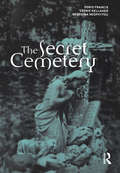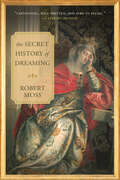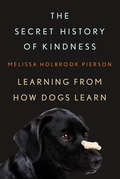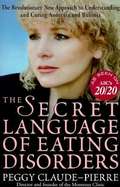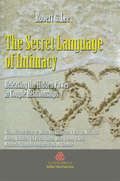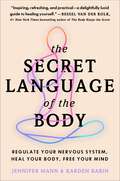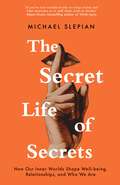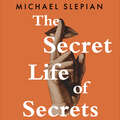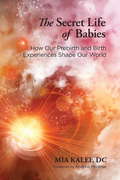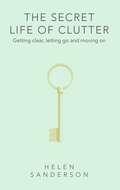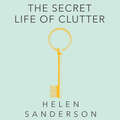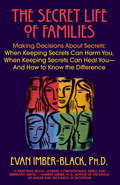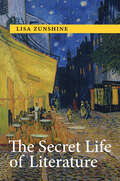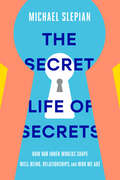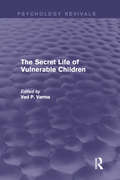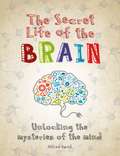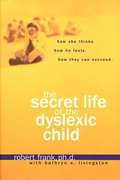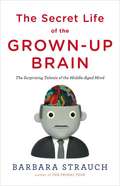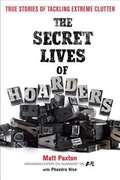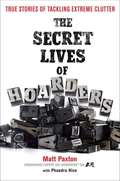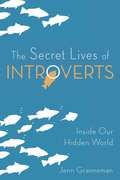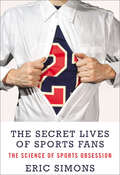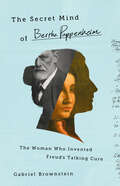- Table View
- List View
The Secret Cemetery
by Leonie Kellaher Doris Francis Georgina NeophytouBurial sites have long been recognized as a way to understand past civilizations. Yet, the meanings of our present day cemeteries have been virtually ignored, even though they reveal much about our cultures. Exploring an extraordinarily diverse range of memorial practice - Greek Orthodox, Muslim, Jewish, Roman Catholic and Anglican, as well as the unchurched - The Secret Cemetery is an intriguing study of what these places of death mean to the living. Most of us experience cemeteries at a ritualized moment of loss. What we forget is that these are often places to which we return either as a general space in which to contemplate or as a specific site to be tended. These are also places where different communities can reinforce boundaries and even recreate a sense of homeland. Over time, ritual, artefact and place shape an intensely personal landscape of memory and mourning, a landscape more alive, more actively engaged with than many of the other places we inhabit.
The Secret History of Dreaming
by Robert MossDreaming is vital to the human story. It is essential to our survival and evolution, to creative endeavors in every field, and, quite simply, to getting us through our daily lives. All of us dream. Now Robert Moss shows us how dreams have shaped world events and why deepening our conscious engagement with dreaming is crucial for our future. He traces the strands of dreams through archival records and well-known writings, weaving remarkable yet true accounts of historical figures who were influenced by their dreams. In this wide-ranging, visionary book, Moss creates a new way to explore history and consciousness, combining the storytelling skills of a bestselling novelist with the research acumen of a scholar of ancient history and the personal experience of an active dreamer.
The Secret History of Kindness: Learning from How Dogs Learn
by Melissa Holbrook PiersonAn intimate, surprising look at man's best friend and what the leading philosophies of dog training teach us about ourselves. Years back, Melissa Holbrook Pierson brought home a border collie named Mercy, without a clue of how to get her to behave. Stunned after hiring a trainer whose immediate rapport with Mercy seemed magical, Pierson began delving into the techniques of positive reinforcement. She made her way to B. F. Skinner, the behavioral psychologist who started it all, the man who could train a pigeon to dance in minutes and whose research on how behavior is acquired has ramifications for military dolphin trainers, athletes, dancers, and, as he originally conceived, society at large. To learn more, Pierson met with a host of fascinating animal behaviorists, going behind the scenes to witness the relationships between trainers and animals at the National Zoo in Washington, DC, and to the in-depth seminars at a Clicker Expo where all the dogs but hers seemed to be learning new tricks. The often startling story of what became of a pathbreaking scientist's work is interwoven with a more personal tale of how to understand the foreign species with whom we are privileged to live. Pierson draws surprising connections in her exploration of how kindness works to motivate all animals, including the human one.
The Secret Language of Eating Disorders
by Peggy Claude-Pierre"I feel so dirty, hopeless, no-good, fat, scared, a failure. I don't deserve to live. " "My daughter is 5'8" and 60 pounds. She won't comply with anyone. She has ruined the family. " "I can't be cured. I'm too bad. I'm going to have to deal with this the rest of my life. " "My doctor told me that I don't want to grow up. " "I hate myself for being the cause of all of this. " "I don't want my daughter to die. They say we are a dysfunctional family, but we don't fight and we love our daughter. Surely something can be done. " All of these statements are based on myths and misconceptions about anorexia and bulimia. Unfortunately, these myths and others not only deepen the suffering of victims of eating disorders, but shape how we regard and treat those victims. If you are a parent , family member, loved one, or caregiver of a victim, or a victim yourself, you know the punishing pain and sense of hopelessness caused by eating disorders. Now an extraordinary new book offers new hope and help to all whose lives are threatened by these scourges. In The Secret Language of Eating Disorders, Peggy Claude-Pierre, founder of the world-renowned eating disorders program at the Montreaux Clinic in Victoria, Canada, puts these damaging myths to rest and reveals her groundbreaking theories on the ultimate cure for illnesses that current medicine treats with little success. Peggy Claude-Pierre developed her unique insights into eating disorders through successfully treating her own two anorexic daughters and hundreds of acutely ill patients at Montreaux, which specializes in treating victims near death whom doctors and hospitals haven't helped. She became convinced that eating disorders stem from a complex negative mindset. Often established at birth, it causes sufferers to feel an overwhelming sense of worthlessness that frequently results in a slow process of self-destruction. It is Peggy Claude-Pierre's conviction that this mindset--and the resulting eating disorder--can be permanently reversed through a program based on unconditional love, regard, positive reinforcement, easing of the victim's burdens of blame and responsibility, and objectivity training. In The Secret Language of Eating Disorders, Claude-Pierre details her theories on the true causes of anorexia and bulimia and lays out the basis of the Montreaux program, which has an astonishingly high success rate, curing even the gravest cases. She describes the origins of the negative mindset and the five stages of recovery from eating disorders, spotlights the special challenges of coping with them at home, and offers clear, practical guidelines to working effectively with health professionals. She also shares the voices of dozens of former patients who offer their own stories of recovery as inspiration to victims, their families, and loved ones. Peggy Claude-Pierre's heartfelt message of hope is that eating disorders can be cured, not merely managed, and that deep within every person suffering from these illnesses is a loving, deserving soul who can and should be saved. As Peggy Claude-Pierre writes to victims, "You are not failures at life, merely at understanding your own value. Soon professionals across the globe will discontinue treating the symptoms of eating disorders as the cause. " This powerful, compassionate book will revolutionize the way we think about eating disorders and their victims. It will literally save lives.
The Secret Language of Intimacy: Releasing the Hidden Power in Couple Relationships
by Robert LeeIn The Secret Language of Intimacy, shame and its consequences are foregrounded as a major, if not the major, impediment to the healthy functioning in the relationships of couples. In the first part of the book, Robert Lee presents the "Secret Language of Intimacy Workshop," developed and presented for the first time at the 1998 Annual Conference of the Association for the Advancement of Gestalt Therapy. Lee not only describes how the hidden forces of shame and belonging regulate couple dynamics, but also how the workshop itself has facilitated the acceptance of these forces and promoted therapeutic resolution, utilizing clinical vignettes. The second half of the book is comprised of internationally contributed essays from leading names in the Gestalt perspective, each adding to and redefining the role of shame and belonging in the theory and practice of Gestalt couples therapy. Their conclusions, however, are just as insightful for purveyors of other psychoanalytic and psychodynamic therapies as well.
The Secret Language of the Body: Regulate Your Nervous System, Heal Your Body, Free Your Mind
by Jennifer Mann Karden Rabin“Inspiring, refreshing and practical - a delightfully lucid guide to healing yourself.” –Bessel van der Kolk, MD., New York Times bestselling author of The Body Keeps the ScoreFrom two mind-body practitioners comes the new essential self-healing bible—a revolutionary body-first guide to reducing stress, resolving long-term pain, and healing from trauma for good using your body’s own nervous system.Your autonomic nervous system is responsible for the constant but mostly subconscious communication between your brain and body. When you experience stress, anxiety, or trauma, your nervous system formulates responses to keep you alive. But you can also become trapped in survival mode if you’re consistently exposed to unsafe environments, toxic relationships, or destructive thought patterns. When this happens it’s known as nervous system dysregulation or sensitization, which can result in chronic mental and physical pain and confusion, leaving you unable to cope with life’s strains and stresses.Mind-body practitioners Jen Mann and Karden Rabin, co-founders of the Chronic Fatigue School now provide the first in-depth look at nervous system regulation, somatic therapy, Polyvagal theory, the vagus nerve, and the mind-body connection. Combining science-backed insights and hands-on techniques, The Secret Language of the Body teaches you how to move out of survival mode, regulate your nervous system, and heal your mind and body. Rabin and Mann don’t teach stress management, but something far more powerful–how to control your body’s nervous system. With this revolutionary book, you will learn to skillfully speak the language of your body and train it to not only manage stress but achieve personal transformation.The Secret Language of the Body includes helpful illustrations.
The Secret Life Of Secrets: How Our Inner Worlds Shape Well-being, Relationships, and Who We Are
by Michael SlepianAn eye-opening look at why we keep the secrets we keep, how to better understand and cope with them, and when (and how) we should bring them to light.Think of a secret that you're keeping from others. It shouldn't take long. Psychologist Michael Slepian finds that, on average, we are keeping as many as thirteen secrets at any given time. His research, involving more than 50,000 participants from around the world, shows that we most frequently keep secrets about lies we've told, ambitions, addictions, mental health challenges, hidden relationships and financial struggles.Our secrets can weigh heavily upon us. Yet the burden of secrecy rarely stems from the work it takes to keep a secret hidden. Rather, the weight of our secrets comes from carrying them alone. Whether we are motivated to protect our reputation, a relationship, a loved one's feelings, or some personal or professional goal, one thing is clear: holding back some part of our inner world is often lonely and isolating. But it doesn't have to be. Filled with fresh insight into one of the most universal - yet least understood - aspects of human behaviour, The Secret Life of Secrets sheds fascinating new light on questions like: At what age do children develop the cognitive capacity for secrecy? Do all secrets come with the same mental load? How can we reconcile our secrets with our human desires to relate, connect and be known? When should we confess and to whom? And can keeping certain types of secrets actually enhance our well-being? Drawing on over a decade of original research, this book reveals the surprising ways in which secrets pervade our lives, and offers science-based strategies that make them easier to live with. The result is a rare window into the inner workings of our minds, our relationships and our sense of who we are.
The Secret Life Of Secrets: How Our Inner Worlds Shape Well-being, Relationships, and Who We Are
by Michael Slepian'If you've ever wondered why we keep secrets and what motivates us to spill them, look no further' Adam Grant, #1 New York Times bestselling author of Think AgainAn eye-opening look at why we keep the secrets we keep, how to better understand and cope with them, and when (and how) we should bring them to light.Think of a secret that you're keeping from others. It shouldn't take long. Psychologist Michael Slepian finds that, on average, we are keeping as many as thirteen secrets at any given time. His research, involving more than 50,000 participants from around the world, shows that we most frequently keep secrets about lies we've told, ambitions, addictions, mental health challenges, hidden relationships and financial struggles.Our secrets can weigh heavily upon us. Yet the burden of secrecy rarely stems from the work it takes to keep a secret hidden. Rather, the weight of our secrets comes from carrying them alone. Whether we are motivated to protect our reputation, a relationship, a loved one's feelings, or some personal or professional goal, one thing is clear: holding back some part of our inner world is often lonely and isolating. But it doesn't have to be. Filled with fresh insight into one of the most universal - yet least understood - aspects of human behaviour, The Secret Life of Secrets sheds fascinating new light on questions like: At what age do children develop the cognitive capacity for secrecy? Do all secrets come with the same mental load? How can we reconcile our secrets with our human desires to relate, connect and be known? When should we confess and to whom? And can keeping certain types of secrets actually enhance our well-being? Drawing on over a decade of original research, this book reveals the surprising ways in which secrets pervade our lives, and offers science-based strategies that make them easier to live with. The result is a rare window into the inner workings of our minds, our relationships and our sense of who we are.
The Secret Life of Babies
by Mia Kalef Andrew FeldmarA bold affirmation that we are sentient before conception and in the womb, The Secret Life of Babies reveals author Mia Kalef's groundbreaking findings: babies are able to remember their earliest experiences, this consciousness precedes the physical development of the brain itself, and medical interventions during birth--like forceps and Cesareans--can imprint our relationships with the world and disconnect us from our sustainable place in the ecosystem. Kalef provides a six-step protocol for detecting these individual imprints and taking reparative steps for physiological and emotional balance and release. This book offers us an articulate guide to a transformation that can restore our essential nature. From the table of contents:Foreword by Andrew FeldmarIntroduction: The Myth: Science and Experience The Quest: Sparking the Conversation Who Is This Book For? A Song Worth SingingPART ONE: ScienceChapter 1: The First Principle: Babies Remember Their Experiences The Controversy A Place to Begin and End: Returning to Wholeness Essential Nature Essential Movements The Mechanisms The Model Perspectives and PurposesChapter 2: The Second Principle: Consciousness Precedes the Brain Architecture That Supports It The Biological Paradox Brains, Fields, and Development The Effects of Chemical and Emotional FieldsChapter 3: The Third Principle: Babies Are Our Barometers Dominance versus Emergence Historical Cultural Indicators Present-Day Cultural IndicatorsPART TWO: ExperienceChapter 4: The Fourth Principle: It Is Never Too Late to Heal The Vision Horizon Preparing the Way Reclaiming the Body: The Path Home The PrototypePART THREE: MarriageChapter5: The Intuitive Recovery Project The Anatomy of the Intuitive Recovery Project The ProjectChapter 6: SummaryFrom the Trade Paperback edition.
The Secret Life of Clutter: Getting clear, letting go and moving on
by Helen SandersonWhen you get clear about why your clutter is holding you back, you can finally let it go and create the home you love.Our homes have fascinating stories to tell. The spaces we inhabit and the objects within them reflect many aspects of our lives and our inner selves. In The Secret Life of Clutter, ten intimate and touching stories take you on a profound journey as people discover what their cluttered homes reveal about their lives, and make life-changing shifts when they start to let go and move on. The secret to creating a calm and nurturing home is to uncover the psychological reasons that lie beneath your clutter, and to understand that what is blocking you in your home and your life is often the key to moving forwards. Unlocking some of the meaning your possessions may hold can free you to say goodbye to what you no longer need, whilst keeping your precious memories intact. The insights revealed in this book will help you understand some of the factors that may be sabotaging your efforts to make more space. It will inspire you to take action and create a home that you love, that loves you back - a home that reflects who you are and the life you want to live.You'll never look at your clutter - or your home - the same way again.
The Secret Life of Clutter: Getting clear, letting go and moving on (Language Acts and Worldmaking #13)
by Helen Sanderson'A thoughtful and surprisingly emotional account of our complex relationship with stuff ... If you don't want your possessions to possess you, then this is a book you must read' Graham AllcottWhen you get clear about why your clutter is holding you back, you can finally let it go and create the home you love.Our homes have fascinating stories to tell. The spaces we inhabit and the objects within them reflect many aspects of our lives and our inner selves. In The Secret Life of Clutter, ten intimate and touching stories take you on a profound journey as people discover what their cluttered homes reveal about their lives, and make life-changing shifts when they start to let go and move on. The secret to creating a calm and nurturing home is to uncover the psychological reasons that lie beneath your clutter, and to understand that what is blocking you in your home and your life is often the key to moving forwards. Unlocking some of the meaning your possessions may hold can free you to say goodbye to what you no longer need, whilst keeping your precious memories intact. The insights revealed in this book will help you understand some of the factors that may be sabotaging your efforts to make more space. It will inspire you to take action and create a home that you love, that loves you back - a home that reflects who you are and the life you want to live.You'll never look at your clutter - or your home - the same way again.
The Secret Life of Families: When Keeping Secrets Can Harm You, When Keeping Secrets Can Heal You--And How to Know the Difference
by Evan Imber-BlackSecrets come in all shapes and sizes. And for families as well as individuals, they are built on a complex web of shifting motives and emotions. But today, when personal revelations are posted on the Internet or sensationalized on afternoon talk shows, we risk losing touch with how important secrets are--how they are used and abused, their power to harm and heal. In this important work, Evan Imber-Black explores the nature of secrets, helping us understand: The distinction between healthy privacy and toxic secrecy What to tell--and not to tell--young children How to safely confront a family "zone of silence" Why adolescents need to have some secrets--and where to draw the line The effect of "official" secrets, like sealed adoption records and medical testing What to consider before revealing an important secret And much more Filled with moving first-person stories,The Secret Life of Familiesprovides perspective on some of today's most sensitive personal and social issues. Giving voice to our deepest fears and to our power to overcome them, this is a book that will be talked about for years to come.
The Secret Life of Literature
by Lisa ZunshineAn innovative account that brings together cognitive science, ethnography, and literary history to examine patterns of &“mindreading&” in a wide range of literary works.For over four thousand years, writers have been experimenting with what cognitive scientists call &“mindreading&”: constantly devising new social contexts for making their audiences imagine complex mental states of characters and narrators. In The Secret Life of Literature, Lisa Zunshine uncovers these mindreading patterns, which have, until now, remained invisible to both readers and critics, in works ranging from The Epic of Gilgamesh to Invisible Man. Bringing together cognitive science, ethnography, and literary studies, this engaging book transforms our understanding of literary history. Central to Zunshine&’s argument is the exploration of mental states &“embedded&” within each other, as, for instance, when Ellison&’s Invisible Man is aware of how his white Communist Party comrades pretend not to understand what he means, when they want to reassert their position of power. Paying special attention to how race, class, and gender inform literary embedments, Zunshine contrasts this dynamic with real-life patterns studied by cognitive and social psychologists. She also considers community-specific mindreading values and looks at the rise and migration of embedment patterns across genres and national literary traditions, noting particularly the use of deception, eavesdropping, and shame as plot devices. Finally, she investigates mindreading in children&’s literature. Stories for children geared toward different stages of development, she shows, provide cultural scaffolding for initiating young readers into a long-term engagement with the secret life of literature.
The Secret Life of Secrets: How Our Inner Worlds Shape Well-Being, Relationships, and Who We Are
by Michael Slepian&“If you&’ve ever wondered why we keep secrets and what motivates us to spill them, look no further. Michael Slepian has spent the past decade studying the psychology of secrets, and is ready to reveal his findings to the world.&”—Adam Grant, #1 New York Times bestselling author of Think Again Think of a secret that you&’re keeping from others. It shouldn&’t take long; behavioral scientist Michael Slepian finds that, on average, we are keeping as many as thirteen secrets at any given time. His research involving more than 50,000 participants from around the world shows that the most common secrets include lies we&’ve told, ambitions, addictions, mental health challenges, hidden relationships, and financial struggles.Our secrets can weigh heavily upon us. Yet the burden of secrecy, Slepian argues, rarely stems from the work it takes to keep a secret hidden. Rather, the weight of our secrets comes from carrying them alone, without the support of others. Whether we are motivated to protect our reputation, a relationship, a loved one&’s feelings, or some personal or professional goal, one thing is clear: Holding back some part of our inner world is often lonely and isolating. But it doesn&’t have to be.Filled with fresh insight into one of the most universal—yet least understood—aspects of human behavior, The Secret Life of Secrets sheds a fascinating new light on questions like: At what age do children develop the cognitive capacity for secrecy? Do all secrets come with the same mental load? How can we reconcile our secrets with our human desires to relate, connect, and be known? When should we confess our secrets? Who makes for the ideal confidant? And can keeping certain types of secrets actually enhance our well-being?Drawing on over a decade of original research, Slepian reveals the surprising ways that secrets pervade our lives, and offers science-based strategies that make them easier to live with. The result is a rare window into the inner workings of our minds, our relationships, and our sense of who we are.
The Secret Life of Vulnerable Children (Psychology Revivals)
by Ved P. VarmaHow do disturbed children see the world? How can we understand their difficulties? Most children have secret worlds but for some these worlds contain secrets that are both permanent and damaging. Originally published in 1992, this moving account of the secret lives of such vulnerable and disturbed children will enable professionals working with these children to find out what is going on in their minds – what they are thinking, what they are feeling, why they behave as they do. The contributors, all experts in their field at the time, show how vulnerable children can be assessed and how they can be helped most effectively.
The Secret Life of the Brain (Secret Life Of Ser.)
by Alfred DavidIn the long history of the study of anatomy, neuroscience is a relatively new field, and there are plenty of mysteries yet to be uncovered. The Secret Life of the Brain explores the fascinating advances that have been made in the field so far, from the intricacies of memory and intelligence, to the enigmatic workings behind our sense of humour and our dreams. Full of illuminating illustrations and diagrams, this book lifts the lid on how drugs affect the brain; the science behind addiction; how the brain deals with trauma and pain; and the effects on the brain of love, age, and sex. Finally, you'll get a tantalising insight into the cutting-edge theories that are attempting to get behind the elements of neuroscience which we still can't quite explain.
The Secret Life of the Brain (Secret Life of)
by Alfred DavidIn the long history of the study of anatomy, neuroscience is a relatively new field, and there are plenty of mysteries yet to be uncovered. The Secret Life of the Brain explores the fascinating advances that have been made in the field so far, from the intricacies of memory and intelligence, to the enigmatic workings behind our sense of humour and our dreams. Full of illuminating illustrations and diagrams, this book lifts the lid on how drugs affect the brain; the science behind addiction; how the brain deals with trauma and pain; and the effects on the brain of love, age, and sex. Finally, you'll get a tantalising insight into the cutting-edge theories that are attempting to get behind the elements of neuroscience which we still can't quite explain.
The Secret Life of the Dyslexic Child: How She Thinks. How He Feels. How They Can Succeed
by Robert Frank Kathryn E. Livingstonfrom the book jacket Dr. Robert Frank, whose own dyslexia didn’t stop him from becoming an educator, psychologist, and author, takes you inside the emotions and frustrations of children with learning disorders. In Part One, you’ll discover what your child never told you about: How your child’s mind works What your child is feeling The separate worlds of “Us” and “Them” In Part Two, you'll walk in your child’s shoes to see for yourself: * What it’s like to think like a dyslexic * What it feels like to be different * The emotions that can disrupt your child’s progress * How to bridge the gap between your child and others In Part Three, you’ll get a clear picture of: * The diagnosis of learning disorders * How your reaction affects your child In Part Four, you’ll receive expert advice to: * Establish goals for your child * Create a game plan for success, * Work better with teachers * Boost self-esteem * Find success at school, at home, in life Your child isn’t dumb. Your child isn’t lazy. Your child is dyslexic, and needs your help. Your child may need help reading and writing, but more than that, he needs you" to understand him. Now you can, as you. go inside the emotional life of children with learning differences. In The Secret Life of the Dyslexic Child, you’ll finally discover what your child goes through every day You will come to under-1 stand his struggles with things you take for granted, such as reading, writing, memory, and following directions. What’s more, you will learn, step by step, the best ways to help him reach his true potential.
The Secret Life of the Grown-up Brain: The Surprising Talents of the Middle-aged Mind
by Barbara StrauchA leading science writer examines how the brain's capacity reaches its peak in middle age. For many years, scientists thought that the human brain simply decayed over time and its dying cells led to memory slips, fuzzy logic, negative thinking, and even depression. But new research from neuroscientists and psychologists suggests that, in fact, the brain reorganizes, improves in important functions, and even helps us adopt a more optimistic outlook in middle age. Growth of white matter and brain connectors allow us to recognize patterns faster, make better judgments, and find unique solutions to problems. Scientists call these traits cognitive expertise and they reach their highest levels in middle age. In her impeccably researched book, science writer Barbara Strauch explores the latest findings that demonstrate, through the use of technology such as brain scans, that the middle-aged brain is more flexible and more capable than previously thought. For the first time, long-term studies show that our view of middle age has been misleading and incomplete. By detailing exactly the normal, healthy brain functions over time, Strauch also explains how its optimal processes can be maintained. Part scientific survey, part how-to guide, The Secret Life of the Grown-Up Brain is a fascinating glimpse at our surprisingly talented middle-aged minds.
The Secret Life of the Mind: How Your Brain Thinks, Feels, and Decides
by Mariano SigmanFrom a world-renowned leader in neuroscience, a provocative, enthralling journey into the depths of the human mind.Where do our thoughts come from? How do we make choices and trust our judgments? What is the role of the unconscious? Can we manipulate our dreams? In this mind-bending international bestseller, award-winning neuroscientist Mariano Sigman explores the complex answers to these and many other age-old questions. Over the course of his 20-year career investigating the inner workings of the human brain, Dr. Sigman has cultivated a remarkable interdisciplinary vision. He draws on research in physics, linguistics, psychology, education, and beyond to explain why people who speak more than one language are less prone to dementia; how infants can recognize by sight objects they've previously only touched; how babies, even before they utter their first word, have an innate sense of right and wrong; and how we can "read" the thoughts of vegetative patients by decoding patterns in their brain activity. Building on the author's awe-inspiring TED talk, the cutting-edge research presented in The Secret Life of the Mind revolutionizes how we understand the role that neuroscience plays in our lives, unlocking the mysterious cerebral processes that control the ways in which we learn, reason, feel, think, and dream.
The Secret Lives of Hoarders
by Matt PaxtonOn the front lines with extreme hoarders The Secret Lives of Hoarders is much more than harrowing tales of attacking the ugliest, dirtiest, and most shocking hoarding cases in the country. It is a behind-the-scenes look at this hidden epidemic- what it means, how to recognize it before it gets out of hand, and how to deal with it. Through his work with hundreds of clients in the worst circumstances- from the giant "rat's nest" that hid more than $13,000 in cash to a vast cache of cartoon pornography to twenty-five years' worth of unopened mail-Matt Paxton has learned to understand this disorder and his clients' impulses to collect, to speak the hoarders' language, and to reach out to them with compassion and concern while avoiding criticism and judgment. Most important, he guides compulsive hoarders successfully through every step of the clean-up and healing process. The Secret Lives of Hoarders is an engrossing and sometimes unsettling look at extreme clutter but one that helps hoarders, their families, and their friends to find meaning in the chaos. .
The Secret Lives of Hoarders: True Stories of Tackling Extreme Clutter
by Matt Paxton Phaedra HiseOn the front lines with extreme hoarders, The Secret Lives of Hoarders is much more than harrowing tales of attacking the ugliest, dirtiest, and most shocking hoarding cases in the country. It is a behind-the-scenes look at this hidden epidemic--what it means, how to recognize it before it gets out of hand, and how to deal with it. Through his work with hundreds of clients in the worst circumstances-from the giant 'rat's nest' that hid more than $13,000 in cash to a vast collection of mermaid pornography to twenty five years' worth of unopened mail--Matt Paxton has learned to understand this disorder and his clients' impulses to collect, to speak the hoarders' language, and to reach out to them with compassion and concern while avoiding criticism and judgment. Most important, he guides compulsive hoarders successfully through every step of the cleanup and healing process. The Secret Lives of Hoarders is an engrossing and sometimes unsettling look at extreme clutter but one that helps hoarders, their families, and their friends find meaning in the chaos.
The Secret Lives of Introverts: Inside Our Hidden World
by Adrianne Lee Jenn GrannemanAn introvert guide and manifesto for all the quiet ones—and the people who love them. Is there a hidden part of you that no one else sees? Do you have a vivid inner world of thoughts and emotions that your peers and loved ones can’t seem to access? Have you ever been told you’re too "quiet,” "shy,” "boring,” or "awkward”? Are your habits and comfort zones questioned by a society that doesn’t seem to get the real you? If so, you might be an introvert.On behalf of those who have long been misunderstood, rejected, or ignored, fellow introvert Jenn Granneman writes a compassionate vindication-exploring, discovering, and celebrating the secret inner world of introverts that, only until recently, has begun to peek out and emerge into the larger social narrative. Drawing from scientific research, in-depth interviews with experts and other introverts, and her personal story, Granneman reveals the clockwork behind the introvert’s mind-and why so many people get it wrong initially.Whether you are a bona fide introvert, an extrovert anxious to learn how we tick, or a curious ambivert, these revelations will answer the questions you’ve always had: What’s going on when introverts go quiet? What do introvert lovers need to flourish in a relationship? How can introverts find their own brand of fulfillment in the workplace? Do introverts really have a lot to say-and how do we draw it out? How can introverts mine their rich inner worlds of creativity and insight? Why might introverts party on a Friday night but stay home alone all Saturday? How can introverts speak out to defend their needs?With other myths debunked and truths revealed, The Secret Lives of Introverts is an empowering manifesto that guides you toward owning your introversion by working with your nature, rather than against it, in a world where you deserve to be heard.
The Secret Lives of Sports Fans: The Science of Sports Obsession
by Eric SimonsSports fandom is either an aspect of a person's fundamental identity, or completely incomprehensible to those who aren't fans at all. What is happening in our brains and bodies when we feel strong emotion while watching a game? How do sports fans resemble political junkies, and why do we form such a strong attachment to a sports team? Journalist Eric Simons presents in-depth research in an accessible and brilliant way, sure to interest readers of Jonah Lehrer and Malcolm Gladwell. Through reading the literature and attending neuroscience conferences, talking to fans, psychologists, and scientists, and working through his issues as part of a collaboration with the NPR science program RadioLab, Eric Simons hoped to find an answer that would explain why the attractive force of this relationship with treasured sports teams is so great that we can't leave it.
The Secret Mind of Bertha Pappenheim: The Woman Who Invented Freud's Talking Cure
by Gabriel BrownsteinThe story of a patient who changed the world, and the mystery of her illness. In 1880, young Bertha Pappenheim got strangely ill—she lost her ability to control her voice and her body. She was treated by Sigmund Freud&’s mentor, Josef Breuer, who diagnosed her with &“hysteria.&” Together, Pappenheim and Breuer developed what she called &“the talking cure&”—talking out memories to eliminate symptoms. Freud renamed her &“Anna O&” and appropriated her ideas to form the theory of psychoanalysis. All his life, he told lies about her. For over a century, writers have argued about her illness and cure. In this unusual work of science, history, and psychology, Brownstein does more than describe the controversies surrounding this extraordinary woman. He brings Pappenheim to life—a brilliant feminist thinker, a crusader against human trafficking, and a pioneer—in the hustling and heady world of nineteenth-century Vienna. At the same time, he tells a parallel story that is playing out in leading medical centers today, about patients who suffer symptoms very much like Pappenheim&’s, and about the doctors who are trying to cure them—the story of the neuroscience of a condition now called FND.The Secret Mind of Bertha Pappenheim argues for the healing art of listening and describes the new &“talking cures&” emerging out of neuroscience today.
